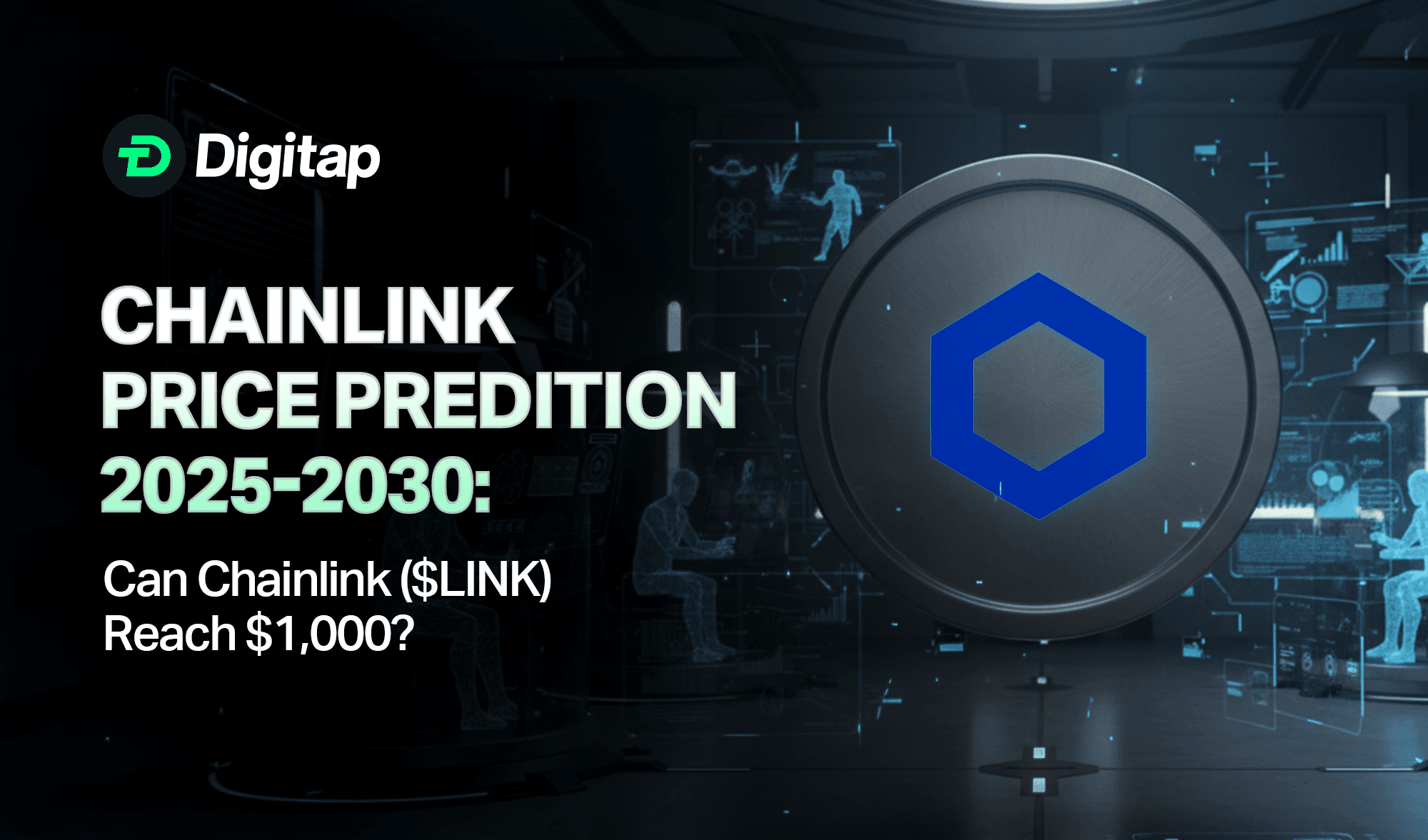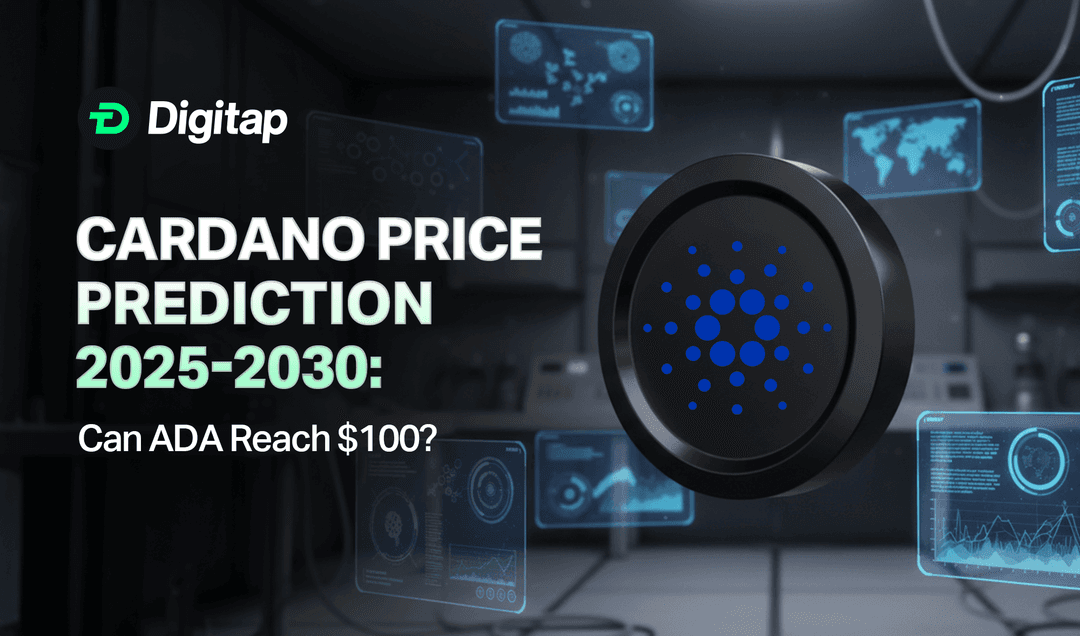Chainlink Price Prediction 2025-2030: Can Chainlink ($LINK) Reach $1,000?
October 30, 2025
The Chainlink Investment Opportunity
Could Chainlink (LINK) become the backbone of the entire blockchain ecosystem and hit a milestone of $1,000 by 2030? With its expanding oracle service, growing enterprise partnerships, and increasing DeFi integration, several investors are wondering if LINK is positioned for unprecedented growth.
Chainlink is a decentralized oracle network designed in 2017 by Sergey Nazarov and Steve Ellis to connect smart contracts with real-world data. With its oracle platform, Chainlink has enabled trillions of dollars in transactions, bridging the gap between traditional finance and blockchain technology, adding a major push towards integrating digital asset banking with DeFi.
This comprehensive analysis examines Chainlink’s price potential from 2025 to 2030, analyzing technical indicators, oracle adoption, fundamental factors, and market conditions that could drive LINK toward the ambitious $1,000 target.
Understanding Chainlink: Technology and Fundamentals
Chainlink has become a key player in decentralized finance (DeFi), serving as the bridge between blockchain systems and real-world data through its oracle network. By allowing smart contracts to access and verify external information securely, Chainlink provides the foundation for building complex and dependable decentralized applications (dApps).
Its oracles facilitate secure computations both on and off-chain, powering what its founders describe as hybrid smart contracts and its cross-chain interoperability protocol, which all run on the Ethereum (ETH) blockchain.
Chainlink underpins more than 2,500 projects across multiple blockchains and industries, establishing itself as the standard for secure off-chain data. Major DeFi platforms like Aave, Synthetix, and Compound use Chainlink’s price feeds to ensure smart contracts execute accurately, supporting key functions such as liquidations, collateral management, and contract settlements.
The network uses a native token, LINK, fundamentally designed to facilitate and incentivize the operation of its decentralized oracle system. LINK is used to settle node operators for supplying off-chain data and computations, and also functions as a staking asset that upholds the network’s security and reliability.
Link Price History and Current Trading Levels
LINK’s price history has been marked by notable volatility, influenced by both network milestones and broader market trends. The token debuted at around $0.17 during the Initial Coin Offering (ICO) boom of 2017. However, it declined to a low of $0.14 in September of the same year during the early stages of Chainlink’s development.
LINK garnered traction again in the 2021 bull market, surging to an all-time high of about $52.88 as adoption of Chainlink’s oracle technology and demand for DeFi protocols using its data feeds increased. The peak coincided with a broader bullish phase across the crypto market, driven by strong speculative interest.
Following the high, LINK underwent a market correction in 2022, settling around $5 as both the token and the wider crypto sector moved into a bearish consolidation.
As digital assets gained attention again following the debut of crypto exchange-traded funds (ETFs) in 2024, LINK traded within a more moderate range, generally between $16 and $25, reflecting reduced volatility compared to its earlier years while remaining sensitive to broader market dynamics and liquidity shifts. The token recorded a yearly high near $30.8 and a low around $10.1.
Large-volume transactions, including notable whale activity in late 2024 and trade wars in 2025, have contributed to short-term price fluctuations, underscoring LINK’s responsiveness to both technical indicators and macroeconomic factors.
As of October 19, 2025, LINK trades at $17.55, with a market cap of $12 billion, supported by a 24-hour trading volume of roughly $610 million, according to CoinGecko data. The token’s fully diluted valuation (FDV) is estimated at $17.39 billion, with 696 million LINK in circulation out of a total and maximum supply of 1 billion tokens.

Fundamental Analysis and Growth Drivers
Chainlink has built significant partnerships with major financial institutions and blockchain projects, stamping its influence as a leading oracle network, particularly in 2025.
This wave of institutional collaboration comes amid growing regulatory clarity for cryptocurrencies worldwide, particularly in the United States. Since President Donald Trump’s inauguration in January 2025, US crypto regulations have taken on a noticeably friendlier stance, aligning with his administration’s goal to position the country as the global hub for digital assets.
As a result, many institutional players have become increasingly receptive to the crypto industry, forming closer partnerships with Chainlink to facilitate real-world assets (RWAs) tokenization, a key step toward broader institutional integration of blockchain technology.
Leading global financial institutions, including JPMorgan, UBS, Deutsche Bank, BNP Paribas, and BNY Mellon, are working with Chainlink to strengthen the accuracy and security of tokenization processes, financial data handling, and decentralized finance infrastructure. This makes Chainlink a leading project in the broader push to make crypto payments for business feasible.
Additionally, Chainlink has also partnered with major organizations such as S&P Global Ratings to bring institutional-grade credit and stability assessments on-chain, highlighting its growing presence in capital markets.
As the global regulatory environment around crypto continues to shift towards a positive side, Chainlink could continue to see increased adoption and ultimately, strong price growth. When performing a Chainlink price prediction, these factors become key trends to watch.
LINK Price Prediction 2025: Short-term Price Prediction
LINK has largely been trading within a descending triangle over the past four years. After declining from its all-time high of $53, established in May 2021, the oracle-based token briefly found support near the 100-week Exponential Moving Average (EMA).
Following the crypto bear market, LINK eventually plunged below the 100-week EMA in January 2022 and consolidated between $5-$10 for nearly two years before picking up pace in October 2023.

LINK surged over 280% between October 2023 to early December 2024 before seeing a rejection at $30 near the upper boundary of the descending triangle. The altcoin ended the year on a downtrend that spanned to April 2025 before bouncing off the support around $10.
LINK began an uptrend in Q2 2025 but again faltered before the triangle’s resistance near $27 in August. The oracle-based token could decline again to test the $10 support if it fails to hold the 100-week EMA. A fall below $10 could send LINK toward the key level near $5.
On the upside, LINK has to clear the descending triangle’s resistance to stage a rally. A firm move above the triangle could see its price rise by over 180% to set a new all-time high at $74. The target is obtained by measuring the height of the triangle and projecting it upward from a breakout point.
However, LINK has to overcome key hurdles at $30, $39, and $53 for such a move to materialize.
LINK/USDT weekly chart.
The Relative Strength Index (RSI) has declined below its yellow moving average line and is testing its neutral level. Meanwhile, the Moving Average Convergence Divergence (MACD) line is on the verge of crossing below its signal line after its histogram bars flipped negative. A firm crossover below in both indicators could accelerate the bearish momentum.
LINK is trading around $17 at the time of publication, down about 25% in 2025.
LINK Price Prediction 2030: Long-Term Vision
For LINK to reach a $1,000 valuation by 2030, the network would require significant and sustained growth across key on-chain and ecosystem metrics.
A $1,000 valuation by 2030 implies LINK has to grow by over 5,500% in the next five years to hit a $1 trillion market capitalization — i.e., if all of its total supply is in circulation. While the figure appears large, considering LINK’s current market cap of $13 billion, such a price growth rate isn’t new to the crypto market due to its high volatility.
The oracle network would need to demonstrate exponential on-chain growth, deep institutional integration, and broad real-world utility, which are fundamental factors for a Chainlink price prediction.
Institutional involvement would play an equally critical role. Partnerships with global financial infrastructure providers such as SWIFT, large-scale integration into tokenized real-world assets, and deeper presence in traditional capital markets would reinforce LINK’s position as the standard for blockchain interoperability.
However, bearish crypto cycles can often offset periods of substantial gains, as noticed in LINK’s price history in earlier sections. Additionally, token unlocks and emissions from staking could weigh down on its price as over 300 million LINK are yet to hit the market.
Ultimately, a $1,000 price target would mean Chainlink has to evolve into the backbone oracle protocol for global finance, securing financial value across decentralized and traditional systems.
Without such a level of adoption and integration, reaching a $1,000 valuation by 2030 remains an extremely ambitious projection rather than a base-case forecast.
Risk Factors and Investment Considerations
While Chainlink holds significant long-term growth potential, several technical and market-related risks could hinder LINK’s path to reaching $1,000 by 2030.
Technology risks
As the decentralized oracle network sector becomes more competitive, Chainlink will need to sustain continuous innovation to maintain its strengths in security, scalability, and reliability. Risks such as technical vulnerabilities, network upgrade delays, or limited developer and institutional engagement could affect future adoption.
The emergence of alternative oracle providers and evolving blockchain technologies may also challenge Chainlink’s market leadership. In addition, integration with new blockchains and real-world asset tokenization systems could introduce adoption or technical hurdles.
Market risks
Broader market volatility, shifting regulatory landscapes, and macroeconomic factors could all constrain LINK’s price performance. The token remains closely tied to wider crypto market cycles, meaning prolonged downturns or stricter regulations may dampen investor sentiment and liquidity.
In addition, token-specific dynamics such as inflation, sell-offs from early holders or large investors, and increasing competition for capital among altcoins could further limit potential price appreciation.
Investment Strategy Recommendations
Investment strategies for Chainlink’s LINK should focus on disciplined risk management, gradual accumulation, and secure storage. Diversifying portfolios and using stop-loss measures can help mitigate downside risk amid market volatility. A dollar-cost averaging (DCA) approach will also allow investors to buy crypto consistently, while minimizing timing risk.
Storing LINK in secure self-custody crypto wallets like Digitap, a no crypto exchange with the lowest fees, and participating in staking can enhance long-term returns by supporting network growth and earning rewards.
Expert Opinions and Market Predictions
Experts remain broadly optimistic about Chainlink’s long-term outlook, citing its core role in blockchain infrastructure. Projections from Coinpedia and Changelly place LINK’s 2030 price between $196 and $253, driven by growing adoption of decentralized oracle technology.
Meanwhile, Investing Haven projects a more moderate range of $81 to $110 for LINK by 2030, tying its potential to the expanding real-world asset tokenization market, which could reach trillions in value. However, Kraken projects a steeper rise to about $22 by 2030, which is well below its all-time high price of $52.70.
The variation in forecasts highlights Chainlink’s shift from a DeFi oracle to a core bridge between traditional finance and blockchain.
Conclusion: Chainlink’s Journey to $1,000
Chainlink has established itself as a vital component of the blockchain economy, powering data connectivity between decentralized applications and the real world. For Chainlink to reach $1,000 by 2030, the network must sustain rapid network expansion and deep integration across the global financial and blockchain landscape.
Reaching such a valuation also depends on favorable macro conditions, supportive regulation, and a sustained bull market that fuels institutional participation. While the target remains ambitious, Chainlink’s expanding role as the backbone of cross-chain interoperability and data connectivity positions it as one of the strongest contenders for long-term value creation in the decentralized economy.
Ready to position yourself for Chainlink’s oracle network growth? Secure your LINK holdings with Digitap’s self-custody solution and participate in staking rewards while maintaining complete control of your blockchain infrastructure investment.

FAQs
What is Chainlink (LINK) and how does it differ from other cryptocurrencies?
Chainlink (LINK) is a decentralized oracle network that enables smart contracts to securely access real-world data, powering automation and interoperability across blockchains.
Unlike typical cryptocurrencies, LINK underpins a data infrastructure used by DeFi, gaming, and enterprise applications rather than serving only as a digital currency.
Can LINK realistically reach $1,000 by 2030?
LINK reaching $1,000 by 2030 cannot be fully determined, but such a rise would depend on strong adoption, institutional support, and favorable market trends. However, technical risks and market volatility make this goal uncertain.
What factors could drive LINK price growth in 2025 and beyond?
LINK’s price growth could be driven by increased adoption of its oracle services, deeper enterprise partnerships, and growing use in DeFi and real-world asset tokenization. Supportive crypto regulations could also boost institutional interest and long-term demand.
How does oracle adoption affect Chainlink’s price potential?
Oracle adoption directly supports LINK’s price potential by driving demand for its services across DeFi, gaming, and institutional use cases. As more projects rely on Chainlink’s oracles for secure data, LINK gains utility and long-term value.
What are the main risks of investing in LINK long-term?
The main long-term risks of investing in LINK include rising competition in the oracle space, evolving blockchain technologies, technical issues, and integration challenges with new systems, which could all impact adoption and Chainlink’s market leadership. LINK is also sensitive to broader crypto market cycles, meaning price may fall during downturns or under stricter regulations, while token-specific risks like inflation and sell-offs from large holders could limit growth.
Where can I safely store and stake my LINK tokens?
You can safely store your LINK using Digitap’s secure self-custody solution, which allows you to stake and earn passive income on your holdings.
How do I analyze LINK’s price charts for trading decisions?
Analyzing LINK’s price involves quality technical analysis. You would need to identify key price movements on the chart and underlying demand and supply zones. Observing the market trend is also important, as it will allow you pinpoint the best time to enter or exit a trade.
Should I stake my LINK tokens for additional rewards?
You should consider staking your LINK tokens to earn rewards, as staking gives you the ability to generate rewards from service fees and participation in the node system, in extension, creates a potentially sustainable income stream while contributing to network security.
How does DeFi growth impact LINK price predictions?
DeFi growth positively impacts LINK price predictions by increasing demand for its oracle services, which are used by major DeFi platforms for functions like liquidations and collateral management. As the DeFi ecosystem expands, wider adoption of these services could drive utility and value for LINK, supporting higher long‑term price targets.
What role does Sergey Nazarov play in Chainlink’s future development?
Sergey Nazarov’s leadership ensures that Chainlink not only maintains its high security and reliability standards but also transforms into the foundational infrastructure that bridges DeFi and traditional finance, which is crucial for large‑scale adoption and long‑term growth.
Share Article

Philip Aselimhe
Philip Aselimhe is a crypto reporter and Web3 writer with three years of experience translating fast-paced, often technical developments into stories that inform, engage, and lead. He covers everything from protocol updates and on-chain trends to market shifts and project breakdowns with a focus on clarity, relevance, and speed. As a cryptocurrency writer with Digitap, Philip applies his experience and rich knowledge of the industry to produce timely, well researched articles and news stories for investors and market enthusiasts alike.






